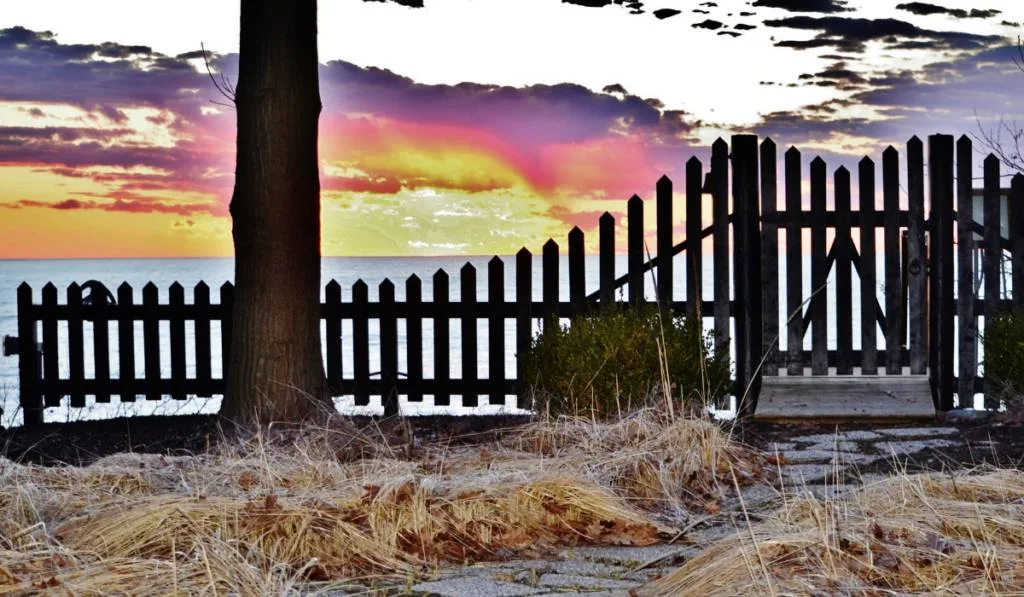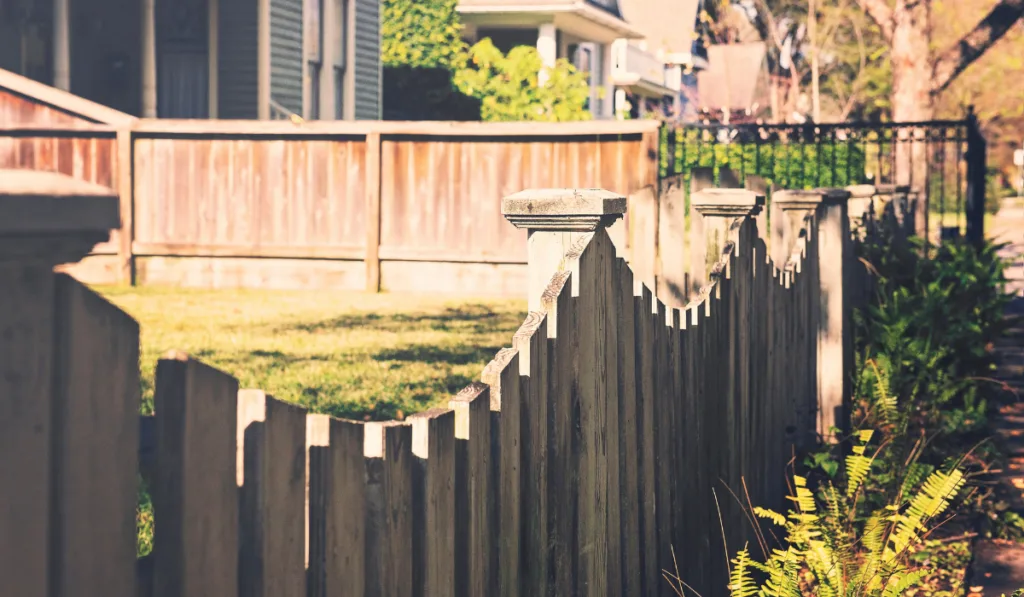Fences come in different shapes and sizes, but the common denominator between almost all of them is the gaps between each fence board. Fences serve as protection against trespassing and enable you to ensure your children and animals stay within your property. While fences serve as a protective measure, due to the gaps in fences, you may find yourself feeling exposed and looking to increase your privacy on your property.
Fences have gaps to enable air to circulate the area the fence surrounds. Having gaps between your fence boards also enables better wind resistance as the gaps ensure that the wind passes through the fence and does not overpower the fence.

Without a fence, your property is exposed, and passers-by are privy to all your activities; however, because fences have gaps, neighbors and those who pass-by can still get a glance into your property and what you are doing on your property. For this reason, it’s important to consider tips for increasing privacy on your fenced property.
Table of Contents
Tips for increasing privacy
Here are some tips to increase the privacy of your property if your property’s fence has gaps that enable passers-by to look into your property.
1. Fence kits
Hardware stores sell fence kits that allow you to DIY your fence to suit your privacy needs. Purchasing fence kits or pre-built panels helps you ensure that you have all the tools you need and that the materials are already cut down to size, saving you both time and effort.
Fence kits are simple to use and are designed with regular people in mind, making them the perfect package to help you construct your fence quickly and efficiently without prior experience.
2. Overlapping fence boards
To achieve a true privacy fence, you can cover the gaps in your fence with fence boards. While this will prevent anyone from looking into your property, it may also affect your ability to see beyond your property’s parameters.
Furthermore, having a fence without gaps may impact the fence’s ability to withstand the wind and prevent good airflow on your property.
3. Homemade wooden fence
If you are unhappy with the existing gaps between your fence boards, adding a homemade wooden fence could help create more privacy. All you’ll need to build a natural fence is a couple of long branches and some wires.
Laying all the branches out in an overlapping row and tying them together horizontally using the wire provides you with an affordable natural fence that doesn’t block the wind nor the sunlight but provides privacy. You could also decorate this fence with artificial flowers or vines to suit your aesthetic.

4. Bamboo
An easy DIY privacy solution is to purchase a roll of bamboo reed fence and attach it to your existing fence. Alternatively, you can create a fence made of bamboo panels.
5. Horsetail grass
Horsetail grass grows between 60cm to 120cm tall. Growing horsetail grass in planters near your fence creates a beautiful aesthetic while providing privacy.
6. Ivy
Decorating your fence with faux ivy leaves can provide great privacy. As an artificial plant, faux ivy will be low maintenance and weather-resistant while providing a natural aesthetic.
7. Hedges
Hedges are a great privacy screening tool as they provide privacy while improving air quality, absorbing pollution, filtering the wind, and provide a home to wildlife. Despite these benefits, it’s important to keep in mind that hedges will house wildlife that may find their way into your home.
Additionally, hedges will require maintenance in the form of watering, plant feeding, and trimming. If you do not enjoy encountering wildlife in your house and don’t see yourself being able to maintain a hedge, then perhaps consider a lower maintenance privacy option.
8. Trees
While you may not want your property surrounded by large trees, planting a tree or two in the right place can give you quite a bit of privacy. It is important to note that your local government may have specific laws regarding tree growth and your neighbor’s rights. Therefore, it would be wise to consult local laws before planting a tree and ensure that your tree does not encroach on your neighbors’ property, block their view or affect their light.
9. Lattice privacy screens
Installing lattice privacy screens is an affordable way to ensure you have a sense of privacy without blocking out the view entirely. Lattice allows you to still enjoy natural light in an aesthetically pleasing manner.
You can decorate your lattice by painting it or adding greenery to it. You can also consider adding vines to your lattice. However, this will require you to maintain the vines. If maintenance is an issue, consider getting artificial plants to decorate your lattice as artificial plants are low maintenance, low cost, weather-resistant, and won’t draw unwanted wildlife to your property
10. Standalone screen
Purchasing standalone sliding privacy screens allows you to choose which area of the property you want to keep private at different times of the day. Unfortunately, these screens will not provide privacy for your entire property and require you to slide it around when you seek privacy, requiring quite a bit of effort.
However, if you tactically place your screen in combination with a tree, it may provide you with adequate privacy in certain areas of your home.
11. Gazebo
While you may not want to install a gazebo around your entire property, you may want some privacy around your garden and pool area. Adding a gazebo with drapes for walls can provide privacy, turning part of your pool area into a changing room or your garden into a shady chill area.

12. Repurpose recyclable materials
You can create a DIY privacy fence by repurposing pallets or using old doors and window frames as privacy screens. Using recyclable materials will not only be good for the environment, and your conscience, but also your budget as these materials are usually relatively cheap, if not free.
Common mistakes of fence building
Accounting for shrinkage
Cedar fence boards shrink once the board dries, which creates a gap between the boards. Therefore, it’s important that you consider shrinkage when you want to build a privacy fence with minimal gaps.
The secret here is to put the cedar fence together with no gaps so that you will only have smaller gaps of approximately 1/4” when the fence is dry.
Alternatively, you can cover the gap with other fence boards, creating an overlap to ensure that there is absolutely no gap.
Not taking board expansion into consideration
As a natural occurrence, when exposed to moisture, wooden boards tend to swell and expand. Having gaps between your boards gives the wood room to expand without ruining the fence design.
If you install the fence boards too close to one another, they will expand when the wood becomes moist, causing the boards to warp.

Design prioritized over functionality
Fence building may require more than one type of wood. However, some try to use only one kind of wood for their fence to match. While aesthetics are important, ensuring you use the correct wood will increase the lifespan of your fence.
Spacing of post holes
Fence post holes should be between six and eight feet apart. If post holes are not spaced properly, this can lead to you having to cut your fence boards down to size to fit the space between each post, which can take time and money.
Alternatively, you may have to dig the post holes again to fit the size of your fence boards which would also be a timeous activity.
Conclusion
The important role that gaps in fences play should not limit your access to privacy. Fences are created to protect your property and should protect your privacy too. Implementing the tips discussed should help keep your property safe and private while still matching the aesthetic of your property.
Resources
- https://www.chainwire-fencing.com/why-do-fences-have-gaps/
- https://fencenews.wordpress.com/2014/01/29/the-3-most-common-mistakes-of-fence-building-building-secrets-that-we-all-should-know/
- https://www.airtasker.com/blog/privacy-fence-ideas/
- https://www.themiddlesizedgarden.co.uk/fences-for-privacy-great-ideas-garden-screening/
- https://www.agfence.ca/news-and-advice/news/News-Advice/2014/06/10/26:top-10-fencing-installation-mistakes
